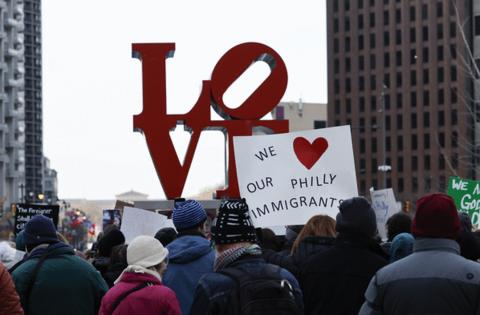Philadelphia says it's a 'welcoming' -- not 'sanctuary' -- city as the Trump administration threatens funding cuts
Published in News & Features
PHILADELPHIA — A Philadelphia that proudly stood among the strongest of sanctuary cities has formally discarded the name.
It’s now a “welcoming city.”
That’s according to Mayor Cherelle L. Parker’s top attorney, who confirmed what has been a slow but dramatic shift in labeling as the Trump administration bears down on the city. Parker administration officials said, however, that policies requiring justice workers to treat immigrants like everyone else remain in place.
Philadelphia was named Thursday night on a Homeland Security list that identified hundreds of so-called sanctuary jurisdictions, all newly threatened with the loss of billions of dollars in federal aid. Cities and counties across the Philadelphia metro region were named too, some of them confused as to how they got there, having never adopted policies around immigration.
Legal battles are sure to follow, as the Trump administration accuses these places of having “deliberately and shamefully” obstructed enforcement of federal immigration laws.
Homeland Security officials claimed again on Thursday that sanctuary jurisdictions protect criminal, undocumented immigrants from facing consequences while putting law enforcement officers in peril.
Officials in many of those places say that’s silly, that they simply choose not to spend local tax dollars to help ICE do its job. Undocumented immigrants living in so-called sanctuary cities are not shielded from federal immigration enforcement, nor from being arrested and charged by local police for local offenses.
But across the nation, “sanctuary” has become increasingly toxic, with more jurisdictions backing away from the term and declaring themselves “welcoming.” It’s a marked tonal shift for Democratic leaders of cities where the earlier response to Trump was often a louder and more assertive defense of their policies.
Baltimore Mayor Brandon Scott, whose city was also named on the list, insisted that Baltimore was not a sanctuary city because it has no jurisdiction over its jails. Not one of the five Democrats representing Philadelphia and its collar counties in Congress, nor Democratic Sen. John Fetterman, responded to requests for comment on being named in the list.
Parker administration officials have avoided speaking the words “sanctuary city,” the mayor criticized by immigrant advocates who have called on her to mount a loud and aggressive defense.
In the midst of the Trump administration’s release of its list on Thursday night, Philadelphia City Solicitor Renee Garcia, a top Parker appointee, declared, “Philadelphia is not a sanctuary city. We are a welcoming city.”
Peter Pedemonti, co-executive director of New Sanctuary Movement of Philadelphia, an advocacy group, said the city administration’s actions are more important than what it calls them.
“What’s essential and what’s important is that they stand firm on the executive orders that prevent collaboration with ICE,” he said. “That’s what matters to families, to people of faith. We don’t need them to fight over a name, we need them to fight over a (Trump) policy.”
The Parker administration said this month it may litigate any Trump attempt to cut federal funds, and “that’s a strong stance,” Pedemonti said.
“Regardless of the name, they need to make sure that people and families in Philadelphia know the policies are in place, and they’re going to stand firm to defend them.”
Trump is striving to carry out what he intends to be the largest deportation effort in American history, seeking to remove millions of people — and trying to compel state and local authorities to help him do it.
The U.S. is home to about 13 million undocumented people, roughly the population of Pennsylvania. But Immigration and Customs Enforcement, the main agency tasked with deportations, employs about 21,000 nationwide, and that includes everyone from administrators to secretaries.
On Friday in Philadelphia, those who are the ultimate targets of Trump’s deportation plans — undocumented immigrants — reacted to his new list with defiance and tears.
“Well, this is stressful, but I can’t keep living with so much fear,” said a 21-year-old woman from Venezuela, throwing up her hands as she cleaned tables at an Italian Market restaurant. “It feels like (President Trump) thinks we are all criminals and that’s not the case. … He sees one and makes us all pay.”
The woman, who agreed to be interviewed if her name was withheld, said she works more than 40 hours a week to help her family at home afford food.
“At this point it’s up to God,” she said. “If (Trump) is going to kick us all out, so be it. But he should think a bit more about all the contributions we bring that will be leaving with us.”
A bakery worker at the market said she was nearly speechless over the release of the list.
“It’s not fair,” said the woman, 52, originally from Mexico, describing how she works seven days a week to help her family and in hopes of someday owning her own business.
“Mr. Trump, we are not all criminals,” she pleaded, holding back tears. “This feels like an attempt to pressure cities to abandon us when we are just trying to work hard, which consequently drives this country forward. … We need Philadelphia to keep being a sanctuary city. Just having the title makes me feel safer.”
Philadelphia has long been a strong leader in sanctuary, as former Mayor Jim Kenney embraced the battle against the first Trump administration.
The famously Irish mayor was captured on video, dancing a jig and calling out “Sanctuary City!” after winning a major 2018 federal court victory that said the president could not end federal grants based on how the city deals with immigrants.
Since January, when asked about the city’s sanctuary status, the Parker administration has reiterated that Kenney’s 2016 executive order on ICE cooperation remains in place. That order directs city authorities not to honor ICE-issued detainers to hold people in custody, unless that paperwork is accompanied by a signed judicial warrant.
Kenney initiated several other, related policies around Trump’s effort to make local police enforce federal immigration laws, kicking ICE out of a database it believed the agency was using to find undocumented people, and barring city employees from asking residents about their immigration status.
Without addressing each specific action, a city spokesperson said late Thursday that all previous immigration policies remain in effect under Parker.
But until Garcia spoke, the city’s shift was never publicly announced.
It’s far from clear whether a change in name will help Philadelphia or other jurisdictions escape Trump’s ire. But that’s the tack city leaders are pursuing as they try to preserve roughly $2 billion in federal funding.
The rhetorical shift is not only meant to avoid being targeted by Trump — although some believe it could help — but to be a more accurate characterization of local policies that often get a city labeled as a “sanctuary.”
“Philadelphia is a welcoming city,” City Councilmember Rue Landau said in a statement Thursday night. “That has been our stance, and this list is Trump’s attempt to instill more fear and uncertainty among the immigrant communities.”
Philadelphia stood among 16 Pennsylvania cities and counties named on the Trump administration list of sanctuary jurisdictions, places to be formally notified of what the president calls their noncompliance with federal immigration law.
The list was released as ICE announced major leadership changes and a White House official said the administration wanted to significantly drive up daily immigration arrests.
Trump won Pennsylvania in the 2024 election, and improved his margins in Philadelphia, with the same campaign playbook that ushered him to office in 2016: attacking Democratic cities and immigrants. The release of a formal list naming hundreds of places across 30 states expands those efforts.
“This is part of a bigger strategy and pattern that we’ve seen utilized time and time again, and that is the use of fear,” said Jasmine Rivera, executive director of the Pennsylvania Immigration Coalition. “What we heard on the campaign trail is an expansion of who is in the cross-hairs.”
Montgomery, Delaware, and Chester Counties were on the list, and so were the cities of Pittsburgh, Gettysburg, State College, and York. New Jersey was named as a sanctuary state. Also cited were Burlington County, Cumberland County, Camden, Trenton, and more than a dozen other Garden State localities.
It’s “deeply troubling that Camden is being singled out” as a sanctuary city, City Council President Angel Fuentes said Friday.
He believes that the city, which once considered but never approved a sanctuary city resolution, is being targeted simply because it’s a diverse, predominantly Latino community. The sanctuary designation, Fuentes said, is “less about policy and more about advancing harmful narratives and punishing communities.”
On Thursday night, Montgomery County Democratic Commissioners Neil Makhija and Jamila Winder sought to “stand up for sanctuary policies,” by signing a statement authored by a group calling itself the Coalition of Local Governments.
More than 50 representatives of municipalities signed on in response to the Trump administration’s publication of its list, the statement asserting that the officials “oppose the Trump administration’s illegal attempts to coerce enforcement of federal immigration law through funding cuts.”
The coalition said that sanctuary policies are legal and make people safer, and that Trump’s executive orders amount to fear tactics.
“To be clear,” the document said, “what’s happening is a blatantly illegal attempt to sidestep Congress and bully local governments into doing ICE’s job by threatening to cut off billions in federal funding.”
(Staff writers Alfred Lubrano and Jesse Bunch contributed to this article.)
©2025 The Philadelphia Inquirer, LLC. Visit at inquirer.com. Distributed by Tribune Content Agency, LLC.







Comments